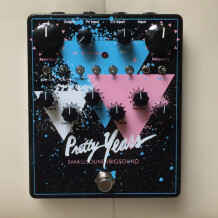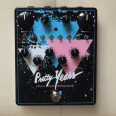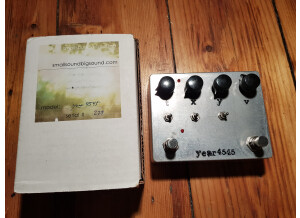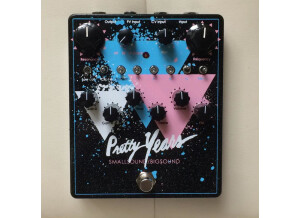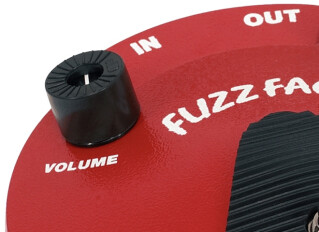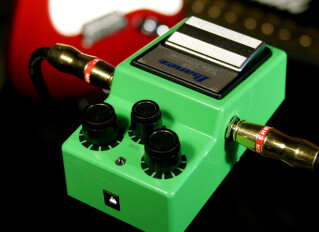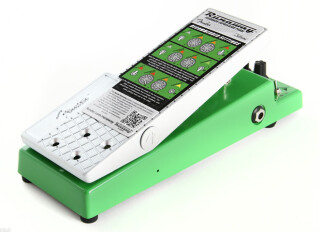Annonces Pretty Years
Alerte nouvelle annonceForums Smallsound/Bigsound Pretty Years
News
Images
Vidéos
Fiche technique
- Fabricant : Smallsound/Bigsound
- Modèle : Pretty Years
- Catégorie : Distorsions Guitare
- Fiche créée le : 12/09/2016
Pretty Years is a high-gain subminiature tube based distortion/fuzz with an interstage resonant lowpass filter to not only filter frequencies, but also shape the texture of the distortion. combining switchable pentode/triode mode, low-voltage biasing, switchable feedback and active bass/treble controls – most drive textures from subtle to complete destruction are available. voltage control over the filter frequency allows for dramatic filter sweeps with expression pedals and total weirdness with modular setups, making Pretty Years a perfect fit for not only guitars, but all other instruments as well.
CONTROLS (from input to output):
Gain stages are indicated as such - MOSFET (I), subminiature tube stages (II, III, IV)
Low cut: cuts the amount of bass at the input, before the MOSFET gain stage. more bass = more gain as you hit the front end with more low end. center - most cut, down - less cut, up - no cut.
Clip I: engages assymetrical diode clipping and some volume boost in the MOSFET gain stage. useful for creating feedback. center - clean, down - some clipping, up - heavy clipping.
Gain II: controls the amount of gain of the 1st tube. this stage is more compressed yet with more
clarity than III. a small compressed hump at the end of the pot’s travel is normal. think of this control like a preamp-gain of sorts. ccw - less gain, cw - more gain.
Gain III: controls the amount of gain of the 2nd tube. this stage is more raw/ragged than II with a more pronounced heavy/low-mid response. this control will also add quite a bit a volume and
drastically affects the response of the Bias control. ccw - less gain, cw - more gain.
Tri/Pent: switches II/III simultaneously to either triode or pentode mode. triode mode is cleaner/softer and has a raspy quality at low Bias settings whereas pentode mode is more aggressive/louder and more compressed at low Bias settings. down - triode mode, up - pentode mode.
Bias: controls the amount of current flowing through the 3rd tube. lower Bias settings will result in less sustain/broken/lo-fi/compressed sounds while higher Bias settings will be cleaner/fuller/much louder. approximately 3 o’clock will be the most full/clean setting (on most units) with a slight amount of distortion introduced when set higher. ccw - lower current, cw - higher current.
Bass/Treble: these controls form a passive James tone stack so they have some interaction. both settings around noon will be fairly close to a flat response, both at minimum will accentuate midrange response and both at maximum will have a scooped response.
ccw - less bass/treble, cw - more bass/treble.
Volume: some settings require maximum volume while other require much less so!
ccw - quieter, cw - louder.
FILTER
HP/BP/LP/Notch: selects filter mode. HP - passes signals with frequencies above the cutoff frequency, BP - passes signals within a certain frequency band, LP - passes signals with frequencies below the cutoff frequency, Notch - attenuates signals within a certain frequency band.
Frequency: sets the cutoff frequency. ccw - lower, cw - higher.
Resonance: sets the gain/peak at the cutoff frequency. at maximum, the filter will oscillate at certain frequencies. ccw - less gain, cw - more gain.
I/II/III/IV (Filter Matrix): these toggles select the point at which the filter is inserted in the circuit and the numeral indicates the gain stage output which feeds the filter input. each setting has it’s own particular sound and if multiple toggles are selected, complex feedback networks are created and certain controls will take on new functions. some settings are wild, some are subtle and require more exploration. I - inserts the filter after gain stage I, II - inserts the filter after gain stage II, III - inserts the filter after gain stage III, IV - inserts the filter after gain stage IV.
FM +/-: engages frequency modulation of the filter based on the Filter Matrix and Gain settings. each mode has a distinct sonic characteristic. (note: if engaged while the filter is not in use there will be a slight reduction in volume) center - off, down - non-inverted, up - inverted.
CV Input: insert a control voltage or external audio signal to control the frequency, where the knob sets the maximum cutoff frequency. +/-9V maximum, TS-jack only.
Autres catégories dans Effets à saturation pour guitare
Autres dénominations : prettyyears


